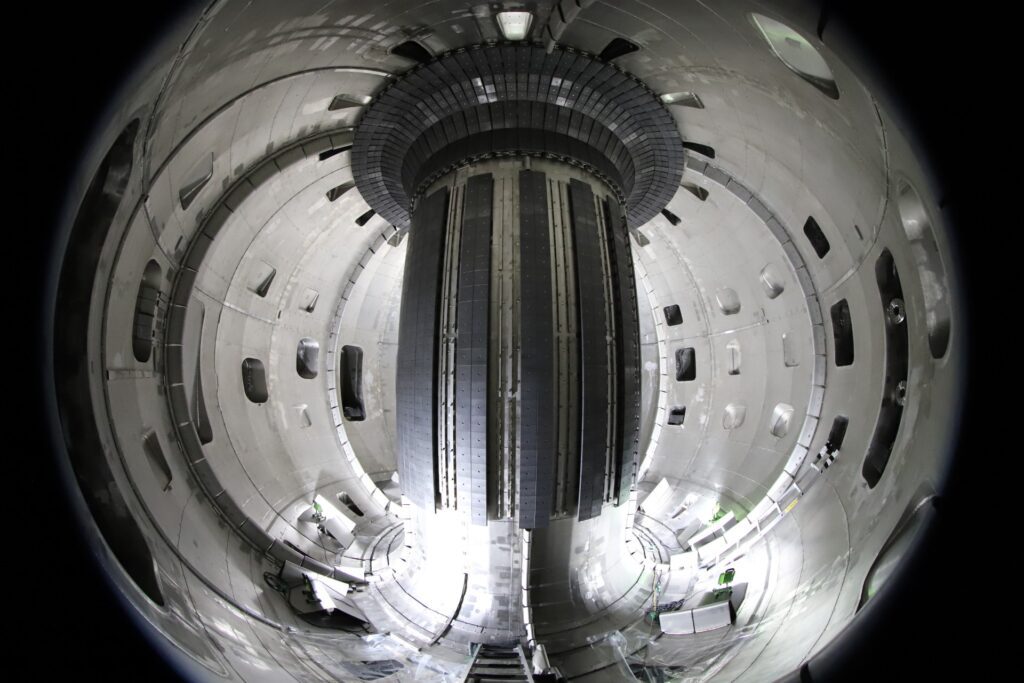Construction in progress at the ITER site, Cadarache, France October 2024. Photo courtesy of ITER Organization
EPSU-Fusion is proud to represent a significant number of F4E staff. EPSU-Fusion is the only union dedicated to staff of the European institutions working in the field of nuclear fusion.

BACKGROUND
Fusion for Energy (F4E) is the European Union organisation managing Europe’s contribution to ITER — the biggest scientific experiment on the path to fusion energy. ITER is currently under construction in Cadarache in the south of France. ITER has seven partners (China, Europe, Japan, India, the Republic of Korea, the Russian Federation and the USA), together representing half of the world’s population and 80% of the global GDP. Each partner has a corresponding Domestic Agency (of which F4E is one) responsible for providing buildings, equipment, components and tools to ITER. Europe is responsible for nearly half of the project, while the other six parties contribute equally to the rest.
F4E’s mission is to bring fusion, the energy of the Sun and the stars, to Earth. To do so, F4E works closely with industry, national laboratories and research organisations to provide the infrastructure and the components of the ITER fusion device. In parallel, F4E is involved in three major fusion R&D projects, stemming from the Broader Approach Agreement signed between Europe and Japan (JT-60SA, IFMIF/EVEDA and IFERC projects). Ultimately, F4E will contribute to the development of demonstration fusion reactors by offering technical know-how and expertise.
F4E was established on 19 April 2007 for a period of 35 years. Its headquarters are in Barcelona (Spain) and it has offices in at the ITER site in Cadarache (France) as well as in Garching (Germany). F4E’s mission is executed by a highly-qualified team of project managers, engineers, physicists, procurement, contract, legal, financial experts and administrators, working at the frontiers of science and technology. EPSU-Fusion is proud to represent a significant number of F4E staff. EPSU-Fusion is the only union dedicated to staff of the European institutions working in the field of nuclear fusion.

Table 1: Staff evolution from 2008 to 2024 where FO stands for Officials, TA for Temporary Agents and CA for Contract Agents.
.
F4E Staff
As of 31 December 2024, the total occupied staff posts at F4E amounted to 438, including 37 Officials, 246 Temporary Agents and 155 Contract Agents. Amongst the agencies, F4E is unusual in having Officials in addition to TAs and CAs.
The staff evolution since 2008 to the end of 2024 can be seen in the table 1.
Allocation of CAs & TAs
Core technical and management positions are allocated as TA or FO positions in the F4E Establishment Plan, while CA positions are used as a more flexible resource. Even though it is not necessary for CAs to be identified in the Establishment Pan, nevertheless CAs needs to be foresee around 2 years in advance to ensure the approval of the necessary budget.
CA / TA positions are governed by different rules and procedures e.g. for recruitment, promotion etc. This means that the additional flexibility and reactivity associated with CA positions is countered by the additional administrative load associated with parallel workflows.
Balance between CAs & TAs
In 2024, around 35% of F4E positions were filled by CAs, with about 57% TAs and the remainder by a decreasing number of Officials. For the remainder of this article we will focus on CAs and TAs only.
The breakdown of CAs and TAs, including gender balance is shown in the table 2.
Observations
- Overall, the number of males (245) is significantly higher than the number of females (149).
- The total number of female TAs is coincidentally the same as the total number of male CAs.
- The total number of male CAs and TAs is coincidentally the same as the total number of TAs, while the total number of females is the same as the total number of CAs.
- Overall, the majority of CAs are female, with the majority of these being FGIII.
- The majority (58) of male CAs are FGIV, compared with only 28 female FGIV.

Table 2 : Comparison between CA & TA by gender and category
Note : FO numbers (total 37) are excluded from this analysis..
CA FGIII colleagues tend to cover tasks equivalent to an AD5 level, while FGIV colleagues cover tasks of an AD6/AD7 level. CA FGIII contracts are common for support and administrative roles. CA FGIV opportunities and AD posts are unusual for support and administrative roles. As the FGIV CAs and AD TAs at F4E are in general in more scientific / technical (including legal, financial, procurement and HR professionals) rather than administrative roles, this indicates that the males dominate the scientific / technical roles. According to F4E, the ratio of males and females in FGIII and FGIV, as well as for TA positions is broadly in line with the ratio of applicants.
F4E notes some difficulty in managing CA roles. Formally, CAs are not supposed to take on the same level of responsibility as their TA colleagues, reflecting the salary difference between the 2 categories. This is reflected in Job Descriptions for the different categories. However, F4E finds that many CA colleagues, given the possibility, tend to want to take more responsibility. This could be due to the generally high level of motivation, or due to other factors such as CAs trying to gain maximum relevant experience in order to be qualified for suitable TA positions which may arise.
Related to this, F4E noted that while there is a process to transition from CA to Official, there is no process to transition from CA to TA. Nevertheless, CAs are often the best-qualified candidates for TA roles and a non-negligible come about naturally as a result.
Feedback from EPSU-Fusion Members at F4E
There is a perception among CAs that AD staff members often look down on colleagues with CA FGIII and lower grades.
Some managers are left with no choice but to require more from CA FGIII colleagues simply because they form the majority of the work force in certain fields.
In addition, there is some evidence that candidates turn down CA FGIII posts and lower at F4E because the salary is not sufficient to meet the cost of living in Barcelona.

Interior of JT-60SA Tokamak. Courtesy: National Institutes for Quantum Science and Technology (QST), Japan
Conclusion
From a management point of view, CAs are an essential resource, representing some 38% of the total complement of CA and TAs at F4E.
Of this 38%, 11.2% are females at FGIII, compared with 14.7% males on FGIV. The remaining 62.2% of the total of CA and TA is split between 45.4% males and only 16.7% females.
F4E management is rightly focused on diversity and gender equality, but so far attention is on gender equality in management roles in line with EC metrics. Clearly, this focus needs to be applied consistently through CAs and TAs at all levels in the organisation. Considering F4E’s observation that the ratio of females to males in CA and TA positions is broadly in line with the ratio of the applicants, let us hope that F4E’s internship and similar activities where efforts are made to encourage female applicants will help to ensure improved gender equality in the pool of applicants in the medium term.
In practice, the tasks performed by CAs in F4E, are often above their pay-grade. This raises potential issues on the chain of formal responsibility. It can also skew the appraisal process. While it is good to note the high level of over-performing CAs, it is an issue that requires more proactive management. It also highlights the need for a formal process to transition from CA to TA.
The author gratefully acknowledges the support of F4E with the preparation of this article.

Brian MACKLIN
ABOUT THE AUTHOR
Brian Macklin started his career as a mechanical engineer working in the car industry and in motorsport, before switching to nuclear fusion starting with JET in 1989 and continuing at ENEA from 1998 to 1999 and then at ITER, where the EC assigned him to work on tokamak assembly from 2006 to the end of 2024. Brian worked with DG INFSO (now CONNECT) in Luxembourg from 1999 to 2005. He has been President of EPSU-Fusion since 2014. Although retied from the EC and ITER since the end of 2024, he remains committed to Nuclear Fusion and to the ITER project. He is particularly motivated to ensure a structured career path in the field of nuclear fusion for young European professionals and in fostering long-term collaboration between ITER, F4E, Eurofusion and the private sector.